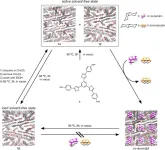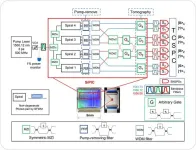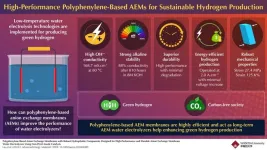(Press-News.org) The world appears to be plagued by crises.
“The financial crisis, the European debt crisis, the migration crisis, the COVID-19 pandemic, the war in Ukraine, the war in Gaza… The world seems to be stumbling from one existential crisis to the next, barely recovering from one before the next one hits,” said Stefan Geiß, a professor from the Department of Sociology and Political Science at the Norwegian University of Science and Technology (NTNU).
However, are there really more crises now than before?
Has it always been this way, or is something new happening? And if there are more public crises today than in the past, what is causing them?
Geiß decided to investigate the matter together with two colleagues, PhD research fellow Conor A. Kelly from the same department and Christina Viehmann from GESIS in Cologne. Their results were recently published in the Journal of Communication.
Data from 1785 to the present day
“We investigated crisis coverage in The Times newspaper spanning 235 years, and found some interesting preliminary results.”
The researchers went all the way back to 1785 to analyze developments in coverage. The Times is a serious, rather conservative newspaper, and is certainly not known for sensationalism.
In order to analyze such vast volumes of information, significant computing power was absolutely essential.
“Our research harnesses the power of computerized text analysis, enabling us to look back in time and see how previous generations understood the crises they faced,” said Geiß.
The analysis focused on news articles in The Times. To check the validity of their analysis, they compared the results with data from The Guardian, The Economist, Neue Zürcher Zeitung, and The Washington Evening Star.
Identified more than 1000 crisis events
“We identified more than 1000 different crisis events that led to major news waves from 20 different types of crises. The most frequent were government crises, geopolitical crises, economic crises, epidemics and disasters,” said Geiß.
So, the fact that the media talk about crises is nothing new, and major news waves tend to occur on average around four times a year. However, while crises in the past were more spread out over time, they now tend to occur in clusters.
“We found that crisis events have become somewhat more frequent, but they tend to occur in more ‘clustered’ or ‘pulsating’ patterns rather than being evenly spread out over time,” said Geiß.
However, there is not necessarily a clear connection between the crises themselves and the crisis coverage.
“The increase in the use of crisis rhetoric is much stronger than the increase in the frequency of crises,” explained the professor.
In other words, crisis rhetoric is used much more frequently than before, but not all of it leads to noticeable news waves. Crisis rhetoric in individual articles does not necessarily create a sense of a public crisis or trigger a wave of news coverage regarding the situation everyone is concerned about.
There is, however, a period that appears quite atypical, as the two largest clusters of crisis waves ever recorded fall within this timeframe: the present.
“News coverage involving crisis rhetoric and the number of crisis events has been much greater in the last two decades than it was previously. The increase in crisis coverage is not just a British phenomenon either; it appears to be a trend in Western countries across various types of media.”
So why is this the case?
Several reasons for the increase in crisis coverage
According to the researchers, crisis rhetoric and to some extent what is portrayed as crisis events appear to be a response to three main factors:
1. Intensified crisis PR.
Interest groups pressure the media into perceiving something as a crisis. There are more of these groups, and they have become more professional. They also cover more different causes and sectors of society. It has therefore become easier for the media to experience, perceive and portray as a crisis events that would probably have been ignored or regarded as less serious in the past.
If something is perceived as a crisis, it increases the possibility that people with power and authority will allocate more money to the area; and the more power news media outlets get, the more relevant this becomes.
2. More diverse public spending across multiple sectors.
This is a complicated point. It concerns how public authorities are much more involved in more aspects of society than before, and how more of us are more concerned with what is happening around us.
For example, a larger proportion of the population is educated, and almost everyone has the right to vote. We therefore perceive it as more important to stay informed about what is happening in our local communities and around the world.
As more people wanted to know how their tax money was being spent and who to vote for, there was a greater interest in news coverage of politics. Mass media quickly gained a larger audience until the market became fully saturated in the 1950s. (See a detailed explanation of the contributing factors in the fact box.)
For politicians, being visible to a wider audience in the media has also become more important.
3. Increasing independence for news media outlets in relation to political parties.
In the past, media outlets were often tied to political parties and therefore not as dependent on making a profit.
An independent press has more power than before, but as competition increases and media outlets must generate a larger share of their revenue themselves, it may also be tempting to use crisis coverage to attract attention and income.
“These three factors are just the tip of the iceberg. The interplay among financial, political and communicative factors is extremely complex,” said Geiß.
However, it seems that the crisis events are less closely connected to crisis coverage than they were in the past. It is not necessarily the case that every event that receives crisis coverage is actually a crisis, and crisis rhetoric is not always effective. Most people do not always perceive events as a crisis, even if the media portrays them as such.
The internet, along with the fact that major media outlets now face both national and international competition to a much greater extent than before, may also be contributing to an increase in crisis coverage, although it is too early to say for sure.
Diverting attention away from other issues
Is it really that dangerous if the media exaggerate a bit from time to time?
“Crisis coverage keeps the public engaged while pushing many other pressing issues to the sidelines,” said Geiß.
The apparent crises divert attention away from issues that are not necessarily as newsworthy, but which may be equally important.
These pertain to worrying developments in society, such as the ever-widening gap between the rich and poor in many countries, or major humanitarian crises that have gradually developed over time.
Reference: Geiß S, Viehmann C, Kelly CA (2024). Inflation of crisis coverage? Tracking and explaining the changes in crisis labeling and crisis news wave salience 1785–2020. Journal of Communication, 2024, jqae033. https://doi.org/10.1093/joc/jqae033
https://academic.oup.com/joc/article/doi/10.1093/joc/jqae033/776040
END
Increase in crisis coverage, but not the number of crisis news events
Researchers looked at nearly 240 years of crisis coverage in The Times to see how coverage has change over time
2024-11-14
ELSE PRESS RELEASES FROM THIS DATE:
New study provides first evidence of African children with severe malaria experiencing partial resistance to world’s most powerful malaria drug
2024-11-14
NEW ORLEANS (November 14, 2024) — A new study from Uganda provides the first evidence to date that resistance to a lifesaving malaria drug may be emerging in the group of patients that accounts for most of the world’s malaria deaths: young African children suffering from serious infections. The study, presented today at the Annual Meeting of the American Society of Tropical Medicine and Hygiene and published in the Journal of the American Medical Association (JAMA), documented partial resistance to the malaria drug artemisinin in 11 of 100 children, ages 6 months to 12 years, who were being treated for ...
Texting abbreviations makes senders seem insincere, study finds
2024-11-14
If you want to seem sincere and receive more responses to your texts, spell out words instead of abbreviating them, according to new research published by the American Psychological Association.
Researchers conducted eight experiments with a total of more than 5,300 participants using various methods. Across the experiments, individuals who used texting abbreviations were perceived as more insincere and were less likely to receive replies because they were seen as exerting less effort in text conversations. The research was published online in the Journal of Experimental Psychology: General.
“In daily interactions, ...
Living microbes discovered in Earth’s driest desert
2024-11-14
Highlights:
The Atacama Desert is one of the most extreme habitats on Earth.
Atacama surface soil samples include a mix of DNA from inside and outside living cells.
A new technique allows researchers to separate external and internal DNA to identify microbes colonizing this hostile environment.
This approach for analyzing microbial communities could potentially be applied to other hostile environments, like those on other planets.
Washington, D.C.—The Atacama Desert, which runs along the Pacific Coast in Chile, is the driest place on the planet and, largely because of that aridity, hostile to most living things. ...
Artemisinin partial resistance in Ugandan children with complicated malaria
2024-11-14
About The Study: This study found artemisinin partial resistance in Ugandan children with complicated malaria associated with the Pfkelch13 A675V variation and also found suboptimal 28-day efficacy of parenteral artesunate followed by oral artemether/lumefantrine therapy.
Corresponding Author: To contact the corresponding author, Chandy C. John, MD, MS, email chjohn@iu.edu.
To access the embargoed study: Visit our For The Media website at this link https://media.jamanetwork.com/
(doi:10.1001/jama.2024.22343)
Editor’s Note: Please see the ...
When is a hole not a hole? Researchers investigate the mystery of 'latent pores'
2024-11-14
Sometimes the holes, or pores, in the molecular structure of a chemical only appear in the presence of certain conditions or other ‘guest’ molecules. This affects the field of separation—one of the most important processes in industry—but researchers have only just begun to unravel this phenomenon
Researchers have explored how a particular chemical can selectively trap certain molecules in the cavities of its structure—even though in normal conditions it has no such cavities. This innovative material with now-you-see-them-now-you-don’t holes could lead to more efficient methods for separating ...
ETRI, demonstration of 8-photon qubit chip for quantum computation
2024-11-14
A group of South Korean researchers has successfully developed an integrated quantum circuit chip using photons (light particles). This achievement is expected to enhance the global competitiveness of the team in quantum computation research.
Electronics and Telecommunications Research Institute (ETRI) announced that they have developed a system capable of controlling eight photons using a photonic integrated-circuit chip. With this system, they can explore various quantum phenomena, such as multipartite entanglement resulting from the interaction of the photons.
ETRI’s extensive research on silicon-photonic quantum ...
Remote telemedicine tool found highly accurate in diagnosing melanoma
2024-11-14
Collecting images of suspicious-looking skin growths and sending them off-site for specialists to analyze is as accurate in identifying skin cancers as having a dermatologist examine them in person, a new study shows.
According to the study authors, the findings add to evidence that such technology could help to reliably address diagnostic and treatment disparities for lower-income populations with limited access to dermatologists. It may also help dermatologists quickly catch cases of melanoma, a serious form of skin cancer that kills more than 8,000 Americans a year.
Their new system, which the researchers call SpotCheck, enables skin cancer specialists ...
New roles in infectious process for molecule that inhibits flu
2024-11-14
COLUMBUS, Ohio – Researchers have identified new roles for a protein long known to protect against severe flu infection – among them, raising the minimum number of viral particles needed to cause sickness.
The protein also helps prevent unfamiliar viruses from mutating after they infect a new host, the study found – meaning its absence during an immune response could enable an animal virus spilled over to people to adapt rapidly to human hosts.
The combined findings by scientists at The Ohio State University add up to potential trouble for people deficient in the protein, called IFITM3 – especially if an avian or swine flu were to gain ...
Transforming anion exchange membranes in water electrolysis for green hydrogen production
2024-11-14
Hydrogen is a promising energy source due to its high energy density and zero carbon emissions, making it a key element in the shift toward carbon neutrality. Traditional hydrogen production methods, like coal gasification and steam methane reforming, release carbon dioxide, undermining environmental goals. Electrochemical water splitting, which yields only hydrogen and oxygen, presents a cleaner alternative. While proton exchange membrane (PEM) and alkaline water electrolyzers (AWEs) are available, they face limitations in either cost or efficiency. PEM electrolyzers, for instance, rely on costly platinum group metals (PGMs) as catalysts, whereas ...
AI method can spot potential disease faster, better than humans
2024-11-14
PULLMAN, Wash. – A “deep learning” artificial intelligence model developed at Washington State University can identify pathology, or signs of disease, in images of animal and human tissue much faster, and often more accurately, than people.
The development, detailed in Scientific Reports, could dramatically speed up the pace of disease-related research. It also holds potential for improved medical diagnosis, such as detecting cancer from a biopsy image in a matter of minutes, a process that typically takes ...
LAST 30 PRESS RELEASES:
New expert guidance urges caution before surgery for patients with treatment-resistant constipation
Solar hydrogen can now be produced efficiently without the scarce metal platinum
Sleeping in on weekends may help boost teens’ mental health
Study: Teens use cellphones for an hour a day at school
After more than two years of war, Palestinian children are hungry, denied education and “like the living dead”
The untold story of life with Prader-Willi syndrome - according to the siblings who live it
How the parasite that ‘gave up sex’ found more hosts – and why its victory won’t last
When is it time to jump? The boiling frog problem of AI use in physics education
Twitter data reveals partisan divide in understanding why pollen season's getting worse
AI is quick but risky for updating old software
Revolutionizing biosecurity: new multi-omics framework to transform invasive species management
From ancient herb to modern medicine: new review unveils the multi-targeted healing potential of Borago officinalis
Building a global scientific community: Biological Diversity Journal announces dual recruitment of Editorial Board and Youth Editorial Board members
Microbes that break down antibiotics help protect ecosystems under drug pollution
Smart biochar that remembers pollutants offers a new way to clean water and recycle biomass
Rice genes matter more than domestication in shaping plant microbiomes
Ticking time bomb: Some farmers report as many as 70 tick encounters over a 6-month period
Turning garden and crop waste into plastics
Scientists discover ‘platypus galaxies’ in the early universe
Seeing thyroid cancer in a new light: when AI meets label-free imaging in the operating room
Neutrophil-to-lymphocyte ratio may aid risk stratification in depressive disorder
2026 Seismological Society of America Annual Meeting
AI-powered ECG analysis offers promising path for early detection of chronic obstructive pulmonary disease, says Mount Sinai researchers
GIMM uncovers flaws in lab-grown heart cells and paves the way for improved treatments
Cracking the evolutionary code of sleep
Medications could help the aging brain cope with surgery, memory impairment
Back pain linked to worse sleep years later in men over 65, according to study
CDC urges ‘shared decision-making’ on some childhood vaccines; many unclear about what that means
New research finds that an ‘equal treatment’ approach to economic opportunity advertising can backfire
Researchers create shape-shifting, self-navigating microparticles
[Press-News.org] Increase in crisis coverage, but not the number of crisis news eventsResearchers looked at nearly 240 years of crisis coverage in The Times to see how coverage has change over time



